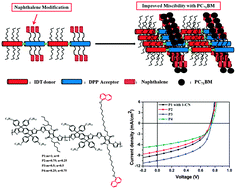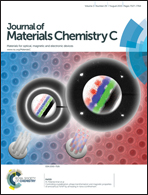Systematic structure modification of a low bandgap conjugated polymer improves thin film morphology and photovoltaic performance by incorporating naphthalene into side chains†
Abstract
In a bulk-heterojunction (BHJ) polymer solar cell, film morphology of the active layer plays a significant role in determining the device performance. For lots of polymers, optimization of BHJ morphology can be achieved by employing high boiling solvent additive such as 1-chloronaphthalene (1-CN). However, the additive process significantly increases the device fabrication complexity and leads to poor reproducibility of the device performance, which is not beneficial to large-scale manufacturing. In this paper, we show that well-organized film morphology can be achieved by systematic modification of the polymer structure. First, a new diketopyrrolopyrrole based monomer with a naphthalene group introduced to the terminal of the alkyl side chain was synthesized. The naphthalene group was incorporated to improve the miscibility of the polymer with a fullerene derivative and help the polymer chains self-assemble into an ordered microstructure for defined film morphology. By simply varying the monomers' ratio in copolymerization, we prepared a series of indacenodithiophene-diketopyrrolopyrrole based polymers namely, P1, P2, P3 and P4, with different contents of naphthalene group functionalized side chains. The influences of naphthalene modification on the optical and electrochemical properties of polymers, film morphology and photovoltaic properties were investigated in detail. As expected, we observed better miscibility without any significant effects on the electronic and optical properties of the polymer for 25% molar percentage of the naphthalene linked monomer employed during polymerization. However, further enhancement of the naphthalene content may decrease π–π stacking, hence leading to reduced optical property and hole mobility. When 50% molar percentage of the naphthalene linked monomer was contained in polymerization, an optimum device efficiency of 4.01% can be achieved, which was much higher than 2.92% for the 1-CN additive optimized non-naphthalene side chain counterpart based device.


 Please wait while we load your content...
Please wait while we load your content...